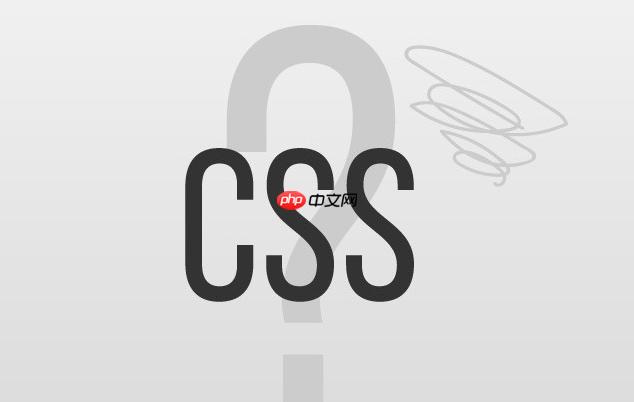答案:通过组合使用元素、属性、类、ID选择器及伪类和组合器,可精准定位并样式化表单元素。具体描述:利用input[type="text"]等属性选择器针对特定输入框,结合.form-control类实现复用,使用:focus、:invalid等伪类增强交互反馈,并通过后代、子代选择器在复杂结构中精确控制样式,提升可维护性与用户体验。

要用CSS路径定位表单元素,尤其是
input
select
在CSS中,定位表单元素的方法多种多样,每种都有其适用场景。我个人在实践中,会根据具体需求和DOM结构来灵活选择。
1. 元素选择器 (Type Selector) 这是最基础的方式,直接选择所有指定类型的元素。
input {
/* 样式应用于所有 input 元素 */
}
select {
/* 样式应用于所有 select 元素 */
}这种方式简单粗暴,但通常用于设置全局的、基础的表单元素样式,比如字体、边框等,作为所有表单元素的默认风格。
2. 属性选择器 (Attribute Selector) 这是定位表单元素最常用的手段之一,特别是针对
input
type
/* 定位所有 type="text" 的 input 元素 */
input[type="text"] {
border: 1px solid #ccc;
padding: 8px;
}
/* 定位所有 type="email" 的 input 元素 */
input[type="email"] {
background-color: #f9f9f9;
}
/* 也可以根据 name 属性来定位 */
input[name="username"] {
font-weight: bold;
}
/* 或者根据 value 属性,虽然不常用,但有时会派上用场 */
input[value="提交"] {
background-color: #007bff;
color: white;
}通过属性选择器,我们可以非常精准地针对特定功能的输入框进行样式定义,这比给每个输入框都加一个类要方便得多。
立即学习“前端免费学习笔记(深入)”;
3. 类选择器 (Class Selector) 当你想为一组具有相似功能或样式的表单元素应用风格时,类选择器是最佳选择。
/* 为所有具有 .form-control 类的元素应用通用样式 */
.form-control {
width: 100%;
box-sizing: border-box;
margin-bottom: 10px;
}
/* 特定的错误输入框样式 */
.input-error {
border-color: red;
box-shadow: 0 0 5px rgba(255, 0, 0, 0.3);
}类选择器提供了极高的灵活性和复用性,特别是在构建组件化的UI时,它几乎是不可或缺的。
4. ID 选择器 (ID Selector) 如果你需要为页面上唯一的某个表单元素应用样式,ID选择器是最具特异性的选择。
/* 为 ID 为 "user-password" 的 input 元素应用样式 */
#user-password {
background-color: #e0e0e0;
}尽管ID选择器特异性很高,但在实际项目中,我个人倾向于少用ID来做样式定位,因为它会限制样式的复用性,并且有时候过高的特异性反而会带来维护上的困扰。
5. 组合器 (Combinators) 当表单元素嵌套在复杂的DOM结构中时,组合器就显得尤为重要了。
/* 后代选择器:选择所有在 form 元素内部的 input 元素 */
form input {
margin-left: 5px;
}
/* 子选择器:选择直接是 .form-group 元素的子元素的 select 元素 */
.form-group > select {
padding: 10px;
}
/* 相邻兄弟选择器:选择紧跟在 label 元素后面的 input 元素 */
label + input {
margin-top: 5px;
}
/* 通用兄弟选择器:选择与 h3 元素同级的后续所有 input 元素 */
h3 ~ input {
border-bottom: 2px dashed blue;
}组合器让我们可以根据元素在DOM树中的相对位置来选择它们,这对于构建清晰的、基于语义的CSS结构非常有帮助。
6. 伪类 (Pseudo-classes) 伪类用于选择处于特定状态的表单元素,这对于提升用户体验和视觉反馈至关重要。
/* 当 input 获得焦点时 */
input:focus {
border-color: #007bff;
box-shadow: 0 0 5px rgba(0, 123, 255, 0.5);
outline: none; /* 移除浏览器默认焦点轮廓 */
}
/* 当 checkbox 或 radio 被选中时 */
input[type="checkbox"]:checked + label {
font-weight: bold;
color: #007bff;
}
/* 当 input 处于禁用状态时 */
input:disabled {
background-color: #f0f0f0;
cursor: not-allowed;
}
/* 当 input 内容无效时(例如 required 字段为空,或 email 格式不正确) */
input:invalid {
border-color: red;
}伪类的应用让表单不仅能响应用户的操作,还能根据其内部状态(如验证结果)动态地改变外观,这在构建交互性强的表单时非常关键。
在我的日常工作中,精准定位特定类型的输入框是一个非常常见的需求。HTML5引入了多种
input
input[type="..."]
比如,当我们需要为文本输入框、密码输入框和电子邮件输入框设置不同的样式时,直接使用它们的
type
/* 所有文本输入框 */
input[type="text"] {
background-color: #f8f8f8;
border: 1px solid #ddd;
border-radius: 4px;
padding: 8px 12px;
}
/* 密码输入框,可能需要一些视觉上的区分,比如字体模糊效果(虽然CSS本身做不到,但可以模拟)或者特殊的图标 */
input[type="password"] {
font-family: 'Segoe UI', Tahoma, Geneva, Verdana, sans-serif; /* 确保字体清晰 */
border-left: 3px solid #007bff; /* 蓝色左边框 */
}
/* 电子邮件输入框,可能需要更严格的视觉提示,比如在无效时 */
input[type="email"] {
color: #333;
/* 浏览器通常会自带一些 email 验证,我们可以利用 :invalid 伪类来增强提示 */
}
/* 提交按钮,通常需要更强的视觉表现 */
input[type="submit"] {
background-color: #28a745; /* 绿色 */
color: white;
padding: 10px 20px;
border: none;
border-radius: 5px;
cursor: pointer;
transition: background-color 0.3s ease;
}
input[type="submit"]:hover {
background-color: #218838;
}
/* 复选框和单选框,它们的默认样式在不同浏览器下差异较大,通常需要重置或自定义 */
input[type="checkbox"],
input[type="radio"] {
/* 很多时候我们会隐藏原生控件,然后用伪元素来模拟自定义样式 */
/* display: none; */
/* ... 配合 label 和伪元素进行样式化 */
}这样做的好处是显而易见的:代码可读性强,维护起来也方便。当产品经理突然要求所有
input[type="email"]
.email-input
input[type="email"].special-style
表单元素不仅仅是静态的HTML组件,它们是用户与网站进行交互的核心。因此,如何通过CSS优雅地响应用户的操作和表单的内部状态,就成了提升用户体验的关键。伪类选择器在这方面简直是神器。它们让我们的表单“活”了起来,提供了丰富的视觉反馈。
我经常用到的伪类包括:
:focus
input:focus,
select:focus {
border-color: #80bdff;
box-shadow: 0 0 0 0.2rem rgba(0, 123, 255, 0.25);
outline: none; /* 移除浏览器默认的蓝色或黑色轮廓,用 box-shadow 代替 */
}通过为聚焦状态添加样式,用户可以清晰地知道当前正在操作哪个输入框,这极大地提高了可用性。
:hover
input
select
:hover
input[type="submit"]:hover {
opacity: 0.9;
}:checked
radio
checkbox
:checked
<!-- HTML 结构示例 --> <input type="checkbox" id="agreeTerms"> <label for="agreeTerms">我同意条款</label>
input[type="checkbox"] {
/* 隐藏原生复选框 */
position: absolute;
opacity: 0;
width: 0;
height: 0;
}
input[type="checkbox"] + label::before {
content: '';
display: inline-block;
width: 16px;
height: 16px;
border: 1px solid #ccc;
background-color: #fff;
margin-right: 8px;
vertical-align: middle;
cursor: pointer;
}
input[type="checkbox"]:checked + label::before {
background-color: #007bff;
border-color: #007bff;
/* 添加一个对勾图标,通常通过 background-image 或伪元素实现 */
background-image: url('data:image/svg+xml;utf8,<svg xmlns="http://www.w3.org/2000/svg" viewBox="0 0 24 24" fill="white"><path d="M9 16.17L4.83 12l-1.42 1.41L9 19 21 7l-1.41-1.41z"/></svg>');
background-size: 100%;
background-repeat: no-repeat;
background-position: center;
}这个例子展示了如何利用
:checked
:disabled
:enabled
input:disabled,
select:disabled {
background-color: #e9ecef;
color: #6c757d;
cursor: not-allowed;
opacity: 0.7;
}:required
:optional
required
:required
input:required {
border-left: 3px solid #dc3545; /* 必填字段左侧加红线 */
}
input:required:focus {
border-left-color: #80bdff; /* 聚焦时变回蓝色 */
}:valid
:invalid
input:valid {
border-color: #28a745; /* 有效时显示绿色边框 */
}
input:invalid {
border-color: #dc3545; /* 无效时显示红色边框 */
}利用
:valid
:invalid
:invalid
required
通过这些伪类的组合使用,我们可以构建出既美观又功能强大的表单,极大地提升了用户体验。这让我觉得CSS在表单交互设计中的作用,远不止于简单的美化,它更是实现良好用户体验的基石。
在构建大型或模块化的Web应用时,HTML结构往往会变得复杂。表单元素可能深埋在多层
div
组合器的威力
当表单元素被包裹在特定容器中时,组合器能帮助我们精确地锁定目标。
后代选择器 (` `):这是最常用的组合器,选择指定元素内部的所有后代元素。
<div class="user-profile-form">
<label>用户名:</label>
<input type="text" name="username">
<div>
<label>邮箱:</label>
<input type="email" name="email">
</div>
</div>/* 选择 .user-profile-form 内部的所有 input 元素 */
.user-profile-form input {
margin-bottom: 15px;
padding: 10px;
border: 1px solid #ddd;
}这种方式非常适合为某个特定区域或组件内的所有表单元素设置统一的基础样式。
子选择器 (>
<form id="registration-form">
<div class="form-row">
<label for="reg-name">姓名:</label>
<input type="text" id="reg-name" name="name">
</div>
<div class="form-row">
<label for="reg-email">邮箱:</label>
<input type="email" id="reg-email" name="email">
</div>
<!-- 这里有个深层嵌套的 input,我们不想影响它 -->
<div>
<p>辅助信息: <input type="text" value="辅助"></p>
</div>
</form>/* 只选择 #registration-form 直接子元素 .form-row 内部的 input */
#registration-form > .form-row > input {
width: calc(100% - 120px); /* 假设 label 宽度为 100px 加上一些 margin */
display: inline-block;
vertical-align: middle;
}
/* 上面的规则不会影响到 <p> 内部的 input */使用子选择器,我可以更精确地控制作用范围,避免不必要的样式冲突。
ID与Class选择器的策略性应用
当组合器还不够时,ID和类选择器就登场了。
ID选择器 (#
<form id="contact-us-form">
<!-- ... -->
<textarea id="message-body"></textarea>
</form>#contact-us-form #message-body {
height: 150px;
resize: vertical; /* 允许垂直方向调整大小 */
}虽然我倾向于少用ID来做样式,但当它与组合器结合时,可以提供无与伦比的精确度,尤其是在需要覆盖某些通用样式时。
类选择器 (.
<form class="product-config-form">
<div class="form-group">
<label for="color-select">颜色:</label>
<select id="color-select" class="form-control item-selector">
<option value="red">红色</option>
<option value="blue">蓝色</option>
</select>
</div>
<div class="form-group">
<label for="quantity-input">数量:</label>
<input type="number"以上就是如何用CSS路径定位表单元素?针对input和select的高效选择方法的详细内容,更多请关注php中文网其它相关文章!

每个人都需要一台速度更快、更稳定的 PC。随着时间的推移,垃圾文件、旧注册表数据和不必要的后台进程会占用资源并降低性能。幸运的是,许多工具可以让 Windows 保持平稳运行。

Copyright 2014-2025 https://www.php.cn/ All Rights Reserved | php.cn | 湘ICP备2023035733号